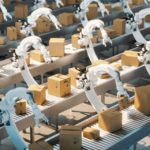 While I have been notably skeptical about the various claims that robots and AI will destroy vast swathes of the jobs we know today, there is an understandable concern about the impact technology is likely to have on the labor market, and especially about how one can go about making our own job as disruption proof as possible.
While I have been notably skeptical about the various claims that robots and AI will destroy vast swathes of the jobs we know today, there is an understandable concern about the impact technology is likely to have on the labor market, and especially about how one can go about making our own job as disruption proof as possible.
Research from the University of Lausanne aimed to find out. The researchers pool together the literature on the capabilities of robotic technology with data on wages and employment to provide what they hope is a realistic picture of the jobs most at risk of being adequately performed by technology in the near future.
What is perhaps most interesting, however, is that they also examine how one might transition from a career that is at risk to one where the chances of automation are less severe (and indeed require the smallest amount of training to make the transition).
“There are several studies predicting how many jobs will be automated by robots, but they all focus on software robots, such as speech and image recognition, financial robo-advisers, chatbots, and so forth. Furthermore, those predictions wildly oscillate depending on how job requirements and software abilities are assessed,” the researchers explain. “Here, we consider not only artificial intelligence software, but also real intelligent robots that perform physical work and we developed a method for a systematic comparison of human and robotic abilities used in hundreds of jobs.”
Likely impact
The researchers created a new approach to mapping the various capabilities of robot technology onto jobs to examine the likelihood that any job might be automated. At the heart of this was the European Commission’s European H2020 Robotic Multi-Annual Roadmap (MAR), which is periodically assessed by robotics experts.
The MAR outlines a range of capabilities of robot technology today, and where the future might take the sector. These capabilities range from being able to manipulate or perceive objects to interacting with humans. Patents, research papers, and product descriptions were trawled through to try and ascertain the maturity level of the various robotic capabilities, with each scored according to the technology readiness level (TRL).
They then gauged human ability via the O*net database, which is a widely-used resource covering the American job market. The database classifies around 1,000 occupations and also breaks each down according to the skills and knowledge that are key to doing them well. This allowed the researchers to pair up human abilities from the O*net database with the robotic capabilities from the MAR database, and therefore then predict how likely it was that each job could be performed by a robot.
Jobs ranking
The result of the process was a ranking consisting of around 1,000 jobs in order of their likelihood of being automated. At the bottom end of the spectrum are roles, such as “physicist”, which have a low chance of being automated, with roles, such as “meat packer”, at the high risk end of the spectrum. Indeed, jobs in areas such as food processing and maintenance consistently featured at the high risk end of the ranking.
“The key challenge for society today is how to become resilient against automation” the researchers explain. “Our work provides detailed career advice for workers who face high risks of automation, which allows them to take on more secure jobs while re-using many of the skills acquired on the old job. Through this advice, governments can support society in becoming more resilient against automation.”
Perhaps the most interesting aspect of the research is the attempt by the researchers to identify alternative jobs that have both a lower likelihood of automation and also sufficient similarity with the original role to allow for an easier transition. The aim is to require as little training as possible to make the transition, and therefore make it a feasible one.
Put to the test
The method was tested on real-life data from the US workforce that allowed them to simulate thousands of different career moves that were based on the suggestions made by the algorithm. The researchers believe it clearly showed that the recommendations would allow people to move from high risk occupations to medium-risk occupations, all while needing relatively modest retraining efforts.
The researchers hope that their approach could be utilized by governments both to understand how at risk people are from automation and also to ensure that retraining policies are adequate both in terms of their level and their direction.
What’s more, they have also used the approach to underpin a tool that they believe accurately predicts the risk of automation, and possible career transitions, for hundreds of jobs that they have made available to the public.